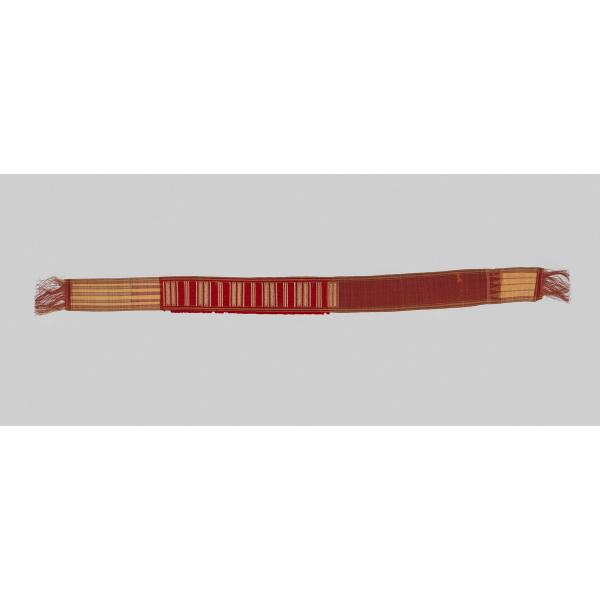Dohr (men’s sash)
The present work is from Pohnpei, where the sashes were known as tor. Reserved exclusively for high-ranking men, tor were ceremonial regalia, worn as belts over grass skirts during dances and feasts. The sashes were woven from fiber obtained from the tough, stringy trunks of banana trees, either left in its natural light tan color or tinted red, black, or light purple with vegetable or mineral dyes. Adorned with intricate geometric motifs, the ornamentation of the sashes varied greatly and the right to use some patterns and colors belonged exclusively to particular families. In the late nineteenth and early twentieth century, weavers frequently, as here, embellished the indigenous banana fiber by interweaving it with red yarn obtained from European traders.
Artwork Details
- Title:Dohr (men’s sash)
- Artist:Pohnpeian artist
- Date:late 19th–early 20th century
- Geography:Federated States of Micronesia, Caroline Islands, Pohnpei
- Culture:Caroline Islands, Pohnpei
- Medium:Banana fiber, wool
- Dimensions:W. 4 3/4 × L. 72 7/8 in. (12.1 × 185.1 cm)
- Classification:Basketry-Costumes
- Credit Line:Purchase, Caroline H. Newhouse Foundation Inc. Gift, 1982
- Object Number:1982.351
- Curatorial Department: The Michael C. Rockefeller Wing
Audio

1773. Dohr (men's sash), Pohnpeian artist
Emelihter Kihleng
EMELIHTER KIHLENG: I think about the treasures themselves and how they’re feeling, and how perhaps they see themselves as relics because they’ve been in these institutions for so long. I’m Emelihter Kihleng. I’m a poet, I’m a curator…
KATERINA TEAIWA (NARRATOR): Kihleng is from Pohnpei, where this dohr or belt was made. Dohr were worn by the highest-ranking male chiefs.
EMELIHTER KIHLENG: But women were the ones who wove the dohr.
KATERINA TEAIWA: In this way, dohr unite the power of the women who made them, and the men who wore them.
EMELIHTER KIHLENG: They were imbued with the essence or the manaman, the kind of spiritual power of the wearer.
KATERINA TEAIWA: Emelihter Kihleng thinks about objects like these as living, animated beings.
EMELIHTER KIHLENG: And maybe they feel completely disconnected from the people that wore them, and that they belong to. And I think that’s where kind of poetry and art is so essential, because it’s a way to kind of communicate with these treasures.
So I’ve actually written quite a few poems about dohr.
So yeah, I wrote this poem about this one.
Dohr, 1982.351
So you were never really asleep.
You whispered in our ears, Hinemoana, and I heard you in Bremen, behind the glass. You’d been dreaming a long dream of liberation, beyond repatriation.
Forget decolonization,
Forget decolonizing,
Forget it.
Here in The Met, I’ve had years to reflect, to meditate. But I’m young in this place. I mean, there’s a copper man with horns, from Mesopotamia, sarcophagi, an Egyptian temple, Mayan snakes, Ming vases, golden statues, distant kin, also breathed the same stale air. Dilukai and her giant labia. Turtle shell money. Jaki-ed. Tapa cloths. Bisj poles, dance masks and fine mats. Here I am a relic, banana fiber and red wool. Sohte ahi peneinei me, apw itar. It’s okay. I too have led many lives. I’ve accepted the fact that I will never be worn again. You should too.
More Artwork
Research Resources
The Met provides unparalleled resources for research and welcomes an international community of students and scholars. The Met's Open Access API is where creators and researchers can connect to the The Met collection. Open Access data and public domain images are available for unrestricted commercial and noncommercial use without permission or fee.
To request images under copyright and other restrictions, please use this Image Request form.
Feedback
We continue to research and examine historical and cultural context for objects in The Met collection. If you have comments or questions about this object record, please contact us using the form below. The Museum looks forward to receiving your comments.
